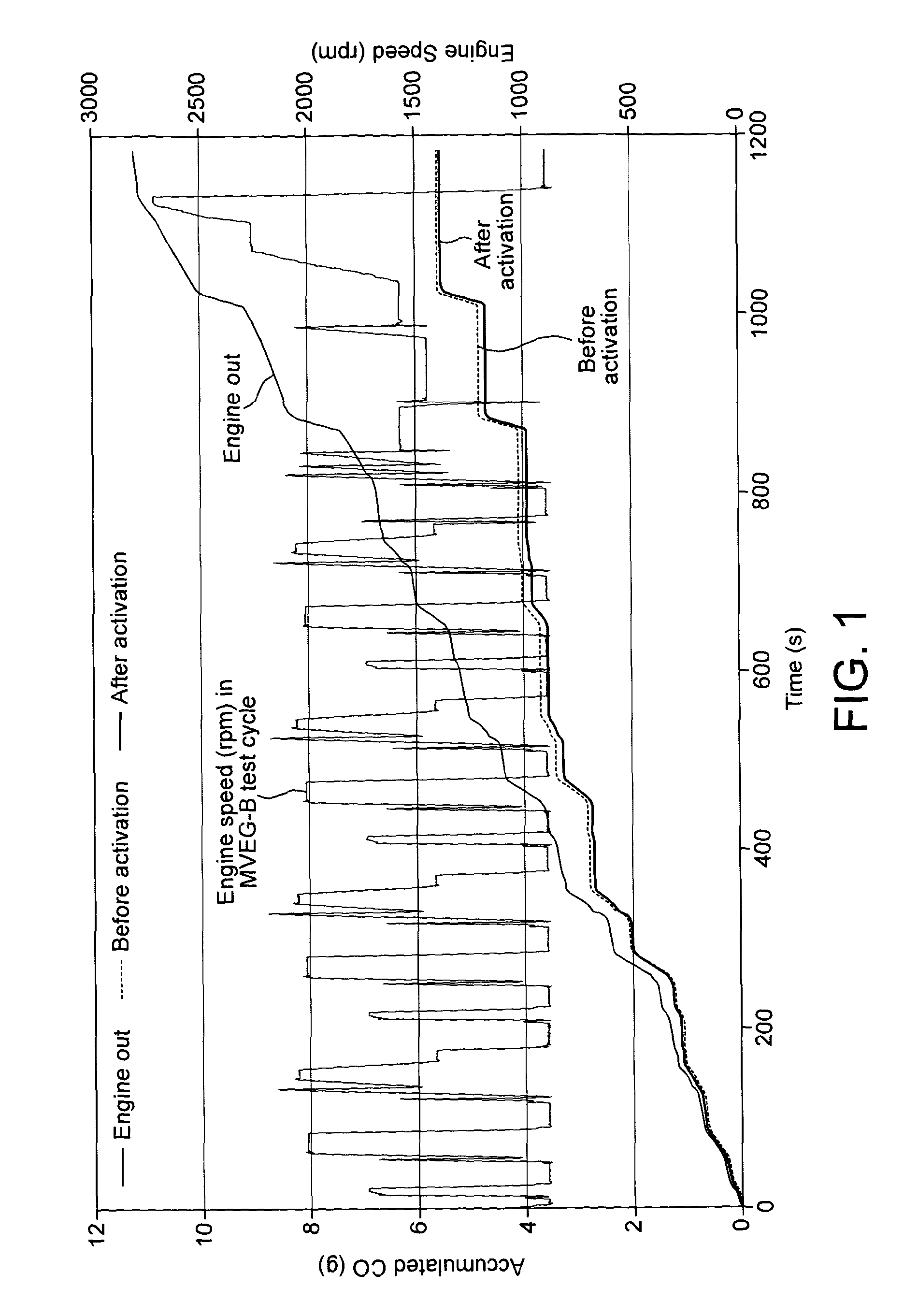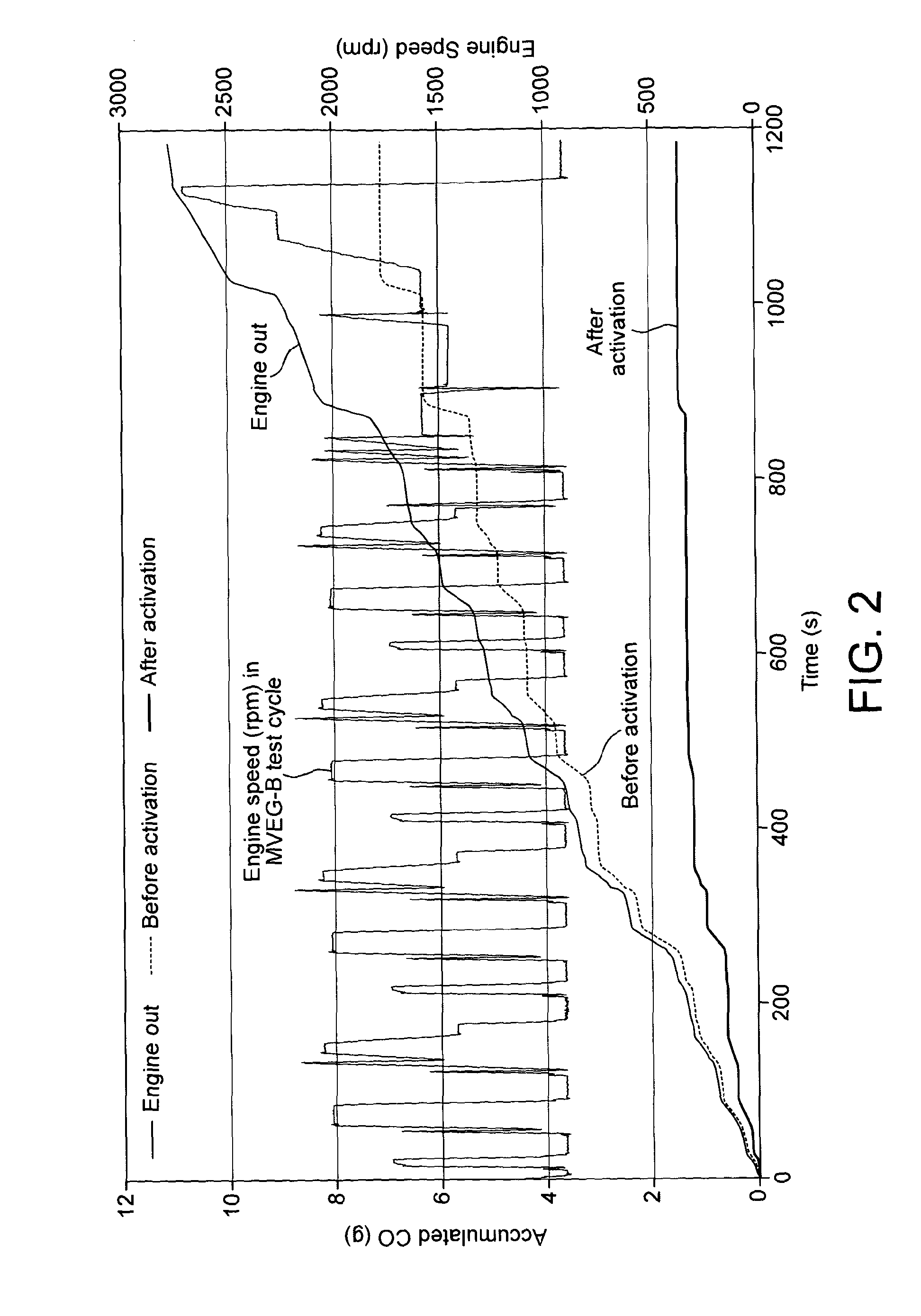Oxidation catalyst for a lean burn internal combustion engine
a technology of oxidation catalyst and internal combustion engine, which is applied in the direction of physical/chemical process catalyst, other chemical processes, separation processes, etc., can solve the problems of increasing catalyst costs, reducing the pt's renowned fresh oxidation activity, and not having sufficient activity at low temperatures for advanced future diesel engines
- Summary
- Abstract
- Description
- Claims
- Application Information
AI Technical Summary
Benefits of technology
Problems solved by technology
Method used
Image
Examples
example 1
Manufacture of Fully Formulated DOC
[0080]A honeycomb 400 cells per square inch flow-through cordierite monolith substrate was coated with a two-layer Conventional catalyst, wherein a first layer comprised 1.67 gin−3 Al2O3 and 0.33 gin−3 Beta zeolite (2 gin−3 washcoat loading in total for the bottom layer) and PtPd and a second, overlayer comprised 0.833 gin−3 Al2O3 and 0.167 gin−3 Beta zeolite (1 gin−3 washcoat loading in total for the top layer) and Pt only. The first layer was applied to a virgin monolith substrate as a washcoat containing salts of Pt and Pd using the methods disclosed in WO 99 / 47260, i.e. comprising the steps of (a) locating a containment means on top, first end of a substrate monolith, (b) dosing a pre-determined quantity of a first washcoat coating component into said containment means, either in the order (a) then (b) or (b) then (a), and (c) by applying pressure or vacuum, drawing said first washcoat coating component into at least a portion of the substrate ...
example 2
Engine Testing of Fully Formulated DOC
[0082]The catalyst of Example 1 was fitted in a pre-existing close-coupled position (i.e. close to the engine exhaust manifold) to a 2.0 litre Diesel bench-mounted engine having an engine management system with a NOx trap engine calibration, i.e. the vehicle as sold is fitted with a NOx trap and NOx trap engine calibration. In our tests, the NOx trap was removed and replaced with a DOC. In a first run, the cumulative CO conversion of the lean hydrothermally aged DOC was tested over the European MVEG-B cycle and the exhaust gas composition was monitored both upstream and downstream of the DOC using an engine dynamometer. No “rich purge” occurred during the cycle, i.e. the engine management system did not switch to a condition adapted to remove and reduce NOx adsorbed on the catalyst. A “rich purge” is used to activate catalysts according to the invention and any rich purge effected during the tests would have made comparison of the results diffic...
example 3
In-Cycle Activation of Fully Formulated DOC
[0085]An identical, lean-hydrothermally aged catalyst according to the invention was prepared as described in Example 1. This catalyst was fitted in the close-coupled position to a bench-mounted 2.0 litre Diesel engine different from the engine used in Example 2, but an engine that was also calibrated for NOx trap regeneration. The engine was run over the European MVEG-B emission cycle and the CO content of the exhaust gas both at engine-out and downstream of the catalyst was monitored using an engine dynamometer. The cumulative CO content of the exhaust gas is shown in the graph at FIG. 3, top left, with the top trace showing CO content in engine-out emissions. CO emissions for this first run were 1.04 g / km.
[0086]Following the first MVEG-B test cycle, a second test was run but in this cycle (shown in the graph at FIG. 4, top right) the engine conducted a NOx purge (or “activation”) event of 8 seconds rich. A third MVEG-B test cycle was per...
PUM
| Property | Measurement | Unit |
|---|---|---|
| Density | aaaaa | aaaaa |
| Flow rate | aaaaa | aaaaa |
Abstract
Description
Claims
Application Information
 Login to View More
Login to View More - R&D Engineer
- R&D Manager
- IP Professional
- Industry Leading Data Capabilities
- Powerful AI technology
- Patent DNA Extraction
Browse by: Latest US Patents, China's latest patents, Technical Efficacy Thesaurus, Application Domain, Technology Topic, Popular Technical Reports.
© 2024 PatSnap. All rights reserved.Legal|Privacy policy|Modern Slavery Act Transparency Statement|Sitemap|About US| Contact US: help@patsnap.com










